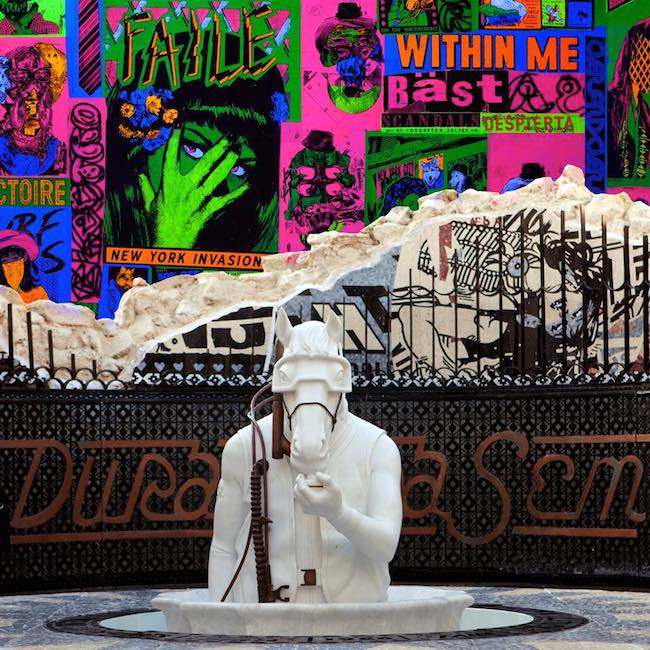Brooklyn art duo FAILE’s exhibition at the Brooklyn Museum, Savage/Sacred Young Minds (July 10 – Oct. 4) feels like an accurate read on my own life. I grew up in a religious household, surrounded by all of the attendant imagery of Christianity. Eventually I rejected that and sought out new symbols and narrative elsewhere, finding potency instead in creativity and the pop culture I’ve loved since I was a kid. Today I’m more likely to get choked up considering the divine, self-sacrificing nature of a character like Peter Parker moreso than Jesus. I traded in old symbols for new ones that filled similar (but more personal) roles.


Above images: FAILE, Temple (detail), part of Savage/Sacred Young Minds at the Brooklyn Museum, 2015. Click to see a larger image.
FAILE shows this transition in their two installations at the Brooklyn Museum. The first, Temple, depicts a holy site that has seen better days. Using iron, ceramic reliefs, painted ceramics and prayer wheels, FAILE’s Patrick McNeil and Patrick Miller and their team made a solemn place, a place that’s worthy of consideration (maybe even respect), but that also feels abandoned. The symbols are there, for those who care to decode them, but it’s an exercise more for an anthropologist or scholar than it is for the faithful.
The artists admit to appropriating their symbols (I’ll leave that for a more politically-minded discussion) but other than the prayer wheels, I wasn’t able to connect the images they used with one specific belief system. Rather, the iconography in Temple is synthetic, intended for us to consider the nature of religious thought and how that meaning is conveyed by images. The artists, in the videos we include below, describe the piece as a search through a cultural landscape and the personal choices people make as they encounter symbols. It may be more useful, they say, to tear down old ones and build something new.

The reliefs in Temple sell that idea by marrying the perceived austerity of religion with symbols that are borrowed from “low” culture, pulp fiction and comic books in particular. A woman climbs out of the jaws of a giant reptile, coming to us from either an ancient creation myth or from Conan the Barbarian. An image of a Native American man flying with an eagle is supported by bombastic text that could either come from scripture or the cover of an oldschool men’s adventure magazine, “Everything in the Sky: The Saved!” In another, a woman created in the style of Japanese manga looks suspiciously like the Virgin Mary. The symbols are interchangeable, their power coming only from the narrative they’re connected to. They’re tools; they’re not divine in and of themselves. Once they’ve served their usefulness, we can set them down and let the temple crumble.


FAILE & BÄST, Deluxx Fluxx Arcade installation at the Brooklyn Museum, 2015. Photographs by Jamie Rojo.
In another room, FAILE and Brooklyn artist’s BÄST’s Deluxx Fluxx Arcade is like Pleasure Island compared to the solemnity of Temple. If we were flirting with pop culture in the reliefs adorning Temple we become zealots of its neon excess in the arcade. The blacklights, custom made video games, pinball and the punk rock posters covering the walls (a nod to FAILE and BÄST’s roots as street artists) feel hedonistic, but the arcade is a shrine too. One of the great things about being a geek is the intoxicating thrill of finding more and more things that speak to your interests. Comics, video games and music can feel like a singularity of light, sound and color. You’re tempted to drown yourself in it. Temple is an invitation to pause and reflect, Deluxx Fluxx Arcade instead nudges you toward endless motion and infinity. Add a fridge of cold beers and I’d prefer this heaven over any of the others I’ve read about.
If FAILE continues their work of combining contemporary ceramic art and pop culture they should consider taking the arcade out of the museum and moving it somewhere more in line with its roots, like a dive bar, a comic book store or a club. There’s a potential for dialogue here with creatively-minded people who are more likely to see a punk rock show than go to a gallery. In particular, I’m thinking about the custom-designed arcade games (not cabinets, mind you, games) that are based on topics such as gentrification, drugs or trying to find a parking space in Brooklyn. Deluxx Fluxx comes at a time in video game culture where its fans are looking at the 40-year history of gaming with a critical eye. It would be interesting for some of those critics to explore that piece of the show in depth.
Bill Rodgers is a Contributing Editor at CFile.
Any thoughts about this post? Share yours in the comment box below.


Photograph by Jonathan Dorado, Brooklyn Museum.

Photograph by Jamie Rojo.


Photograph by Jamie Rojo.

Installation views of FAILE’s “Temple” at the Brooklyn Museum, 2015.

FAILE in their Greenpoint, Brooklyn studio. Photograph by Rayon Richards.







Add your valued opinion to this post.